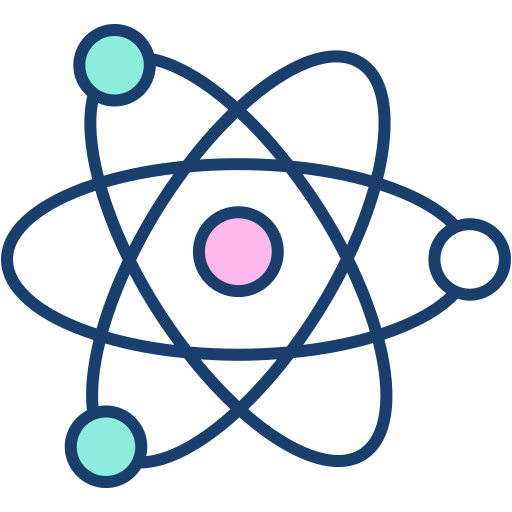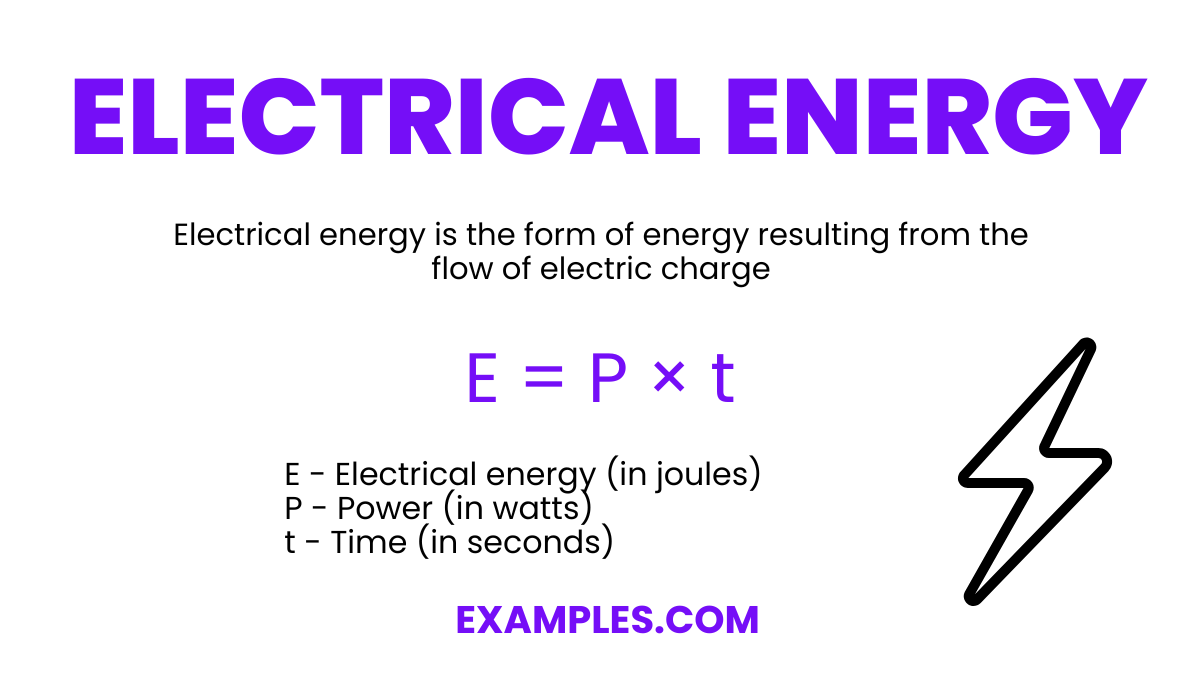What is the unit of electrical energy?
Volt
Ampere
Watt-hour
Coulomb


Electrical energy is a fundamental concept in both physics and everyday life, powering countless devices and systems. This guide offers an in-depth look into electrical energy, explaining its principles, applications, and importance in a clear, accessible manner. Tailored for educators, it provides engaging examples and straightforward explanations, making it an invaluable resource for teaching and understanding this essential form of energy.
Electrical energy is the form of energy resulting from the flow of electric charge. It’s a versatile and widely used energy source, driving the functionality of numerous devices and technologies. Understanding electrical energy is crucial in the modern world, where electricity is a cornerstone of daily life. This concept is integral in physics, engineering, and technology education.
A prime example of electrical energy in action is the lighting system in homes and buildings. Electrical energy is converted into light energy through light bulbs or LEDs, illuminating spaces effectively and efficiently. This transformation of electrical energy into light is a clear, relatable example that demonstrates its practical application and significance in everyday life.
Electrical energy, also known as electric potential energy, is a fundamental concept in physics. It represents the energy stored in an electric field due to the presence of electric charges. This energy can be calculated using the formula:
E = P × t
Where:
E – Electrical energy (in joules)
P – Power (in watts)
t – Time (in seconds)
The unit of electrical energy is the joule (J), which quantifies the amount of work done or heat produced by an electric current. In practical applications, especially in electricity billing and large-scale energy discussions, kilowatt-hours (kWh) are commonly used. This unit reflects the energy usage over time, crucial for understanding and managing electricity consumption in both domestic and industrial settings.
Electrical energy, a ubiquitous and vital force, powers numerous aspects of modern life. This section presents 22 diverse and illustrative examples of electrical energy, each shedding light on its various applications. Ranging from household appliances to advanced technological systems, these examples demonstrate the extensive role of electrical energy in daily activities and industrial processes. This comprehensive collection serves as an excellent educational tool, helping teachers explain the practical implications and uses of electrical energy in an engaging and relatable manner.
Electrical energy seamlessly integrates into our daily routines, often unnoticed yet essential. This section highlights five unique examples of electrical energy in daily life, showcasing its fundamental role in modern living. From morning rituals to nightly routines, these examples illuminate how electrical energy supports and simplifies our day-to-day activities. Understanding these applications is crucial for educators, providing relatable instances to explain electrical energy’s practical importance.
Electrical energy is a part of children’s everyday experiences, often in playful and educational forms. This section provides five examples, tailored to help kids understand and relate to the concept of electrical energy. These instances are chosen for their simplicity and familiarity, making them ideal for educators to use in teaching young learners about the basics of electricity.
Everyday life is replete with instances where electrical energy plays a crucial role. This section delves into five such examples, emphasizing how electrical energy is woven into various aspects of daily living. These examples are selected to resonate with a broad audience, highlighting the omnipresence and versatility of electrical energy in our daily activities.
Electrical energy, integral to our daily lives and technological advancements, can be broadly categorized into two types: Static Electricity and Current Electricity. Each type has unique characteristics and applications, playing distinct roles in various fields.
Static electricity is the result of an imbalance between positive and negative charges in objects. It occurs when charge builds up on an object’s surface but does not flow. This type of electricity is usually generated through friction between two different materials.
Current electricity is the continuous flow of electric charges through a material, known as an electric current. This form of electricity is what powers most electronic devices and appliances.
Understanding these two fundamental types of electrical energy is crucial for comprehending various phenomena and technological applications in physics, engineering, and everyday life.
Electrical energy is derived from various sources, each playing a pivotal role in powering our world. These sources range from traditional fossil fuels to renewable resources, reflecting the diversity and evolution in energy generation methods. Understanding these sources is essential for comprehending the dynamics of power generation and the transition towards sustainable practices.
Electrical energy serves numerous functions, from powering small gadgets to running entire cities. Its versatility and efficiency make it an indispensable component of modern life. This section explores different functions of electrical energy, highlighting its significance in various domains and technologies.
Electrical energy is indispensable in modern society due to its flexibility, efficiency, and the ease with which it can be transported and converted into other forms of energy. It powers almost all aspects of contemporary life, from basic household needs to advanced technological systems. The importance of electrical energy lies in its ability to support sustained economic growth, enhance quality of life, and drive innovations across various sectors.
In conclusion, electrical energy is a dynamic and essential force driving modern civilization. Its diverse types, sources, and functions underline its integral role in everyday life and technological advancement. Understanding electrical energy is crucial for educators and students alike, as it fosters awareness of its importance and the need for sustainable energy practices.
Electrical Energy has two types of equations that is can be easily inferred from the question. These two electrical energy equations will come in the form of E = Pt or P = E/t, where E is energy in Joules (J), P is Power in Watts (W), and t is Time in seconds (s).
Begin by reading the question and deducing which formula you are going to use as an outline in the equation. After you have determined which formula is needed, you must write down the chosen formula on a piece of paper or digital note-taking software.
You will need to write down the given numbers in the equation. This is to allow you to check if the given numbers are in the correct units. If any of the given numbers are in the wrong unit of measurement then you must convert them accordingly. The given energy should be in Joules (J), the given power should be in Watts (W), and the given time should be in seconds (s).
After ensuring that the given number is in the correct units, you must then substitute the given numbers in the equation. When you have done that, you will now solve the equation through the use of the associated operation needed.
After completing the equation make sure that the answer is using the correct units. If the equation is asking for a unit outside of the equation, you will need to convert your answer to the correct unit of measurement.
A solar panel is an assembled tool or product that can convert, supply, and store solar or radiant energy (see radiation) to electrical energy. A few elements determine the total price the installation will cost, which are the price of the solar panel, the service cost, and misc. costs. The price of high-end solar panels is usually around 21,000 – 36,00 USD while lower-quality solar panels range from 3,000 to 20,000 USD. The place or location where you bought the solar panel will usually offer a free installation service with the purchase of said solar panel. Though some people might instead opt to use a different service or an installation service business to install the said solar panels, which will increase the overall price of the installation.
Power companies are utility-based service businesses that are considered part of the country’s base necessities. These companies provide electrical energy as their main product. This means that almost all the citizens will have to avail of the services produced by power companies, which causes a great demand for electricity in all types of sectors. Some power companies use nuclear energy nuclear reactors generate as an alternative to electrical energy.
Kilowatt (kW) is a measurement of electrical energy most electrical appliances use to gauge their usage of electricity. Not only that, but power companies and other utilities use kW to measure the amount of energy used in a specific building or household. A person can use the kilowatt per hour or kWh to determine and predict the overall electrical bill said person will pay. Electrical energy is a type of kinetic energy that manifests as electrical charges when electrical ions move from one point to another. This is a very important energy source as most of our everyday appliances and gadgets use electrical energy as their power source.
Electrical energy is a specific type or form of kinetic energy that powers most of our modern-day appliances and gadgets. We are very reliant on this form of electrical energy due to our everyday interactions with these specific appliances and gadgets.
Text prompt
Add Tone
22 Electrical Energy Examples
Functions of Electrical Energy
What is the unit of electrical energy?
Volt
Ampere
Watt-hour
Coulomb
Which of the following devices converts chemical energy into electrical energy?
Generator
Battery
Solar panel
Transformer
What is the power consumed by an electrical device that uses 10 A of current at a voltage of 120 V?
1.2 W
12 W
120 W
1200 W
If the resistance in a circuit is doubled, what happens to the current assuming the voltage remains constant?
It doubles
It halves
It remains the same
It becomes zero
Which component stores electrical energy in an electric field?
Resistor
Inductor
Capacitor
Transformer
What is the role of a transformer in an electrical circuit?
To convert DC to AC
To step up or step down voltage
To store electrical energy
To control the flow of current
Which of the following is an example of converting electrical energy to mechanical energy?
A light bulb glowing
A battery charging
A fan spinning
A solar panel generating electricity
What is the current in a circuit with a voltage of 9 V and a resistance of 3 Ω?
3 A
6 A
9 A
27 A
If a device uses 500 W of power for 3 hours, how much energy does it use?
1.5 kWh
2 kWh
0.5 kWh
3 kWh
What is the purpose of a fuse in an electrical circuit?
To amplify the current
To measure the voltage
To store electrical energy
To protect the circuit from overload
Before you leave, take our quick quiz to enhance your learning!

